3D & 4D Technology Market Size
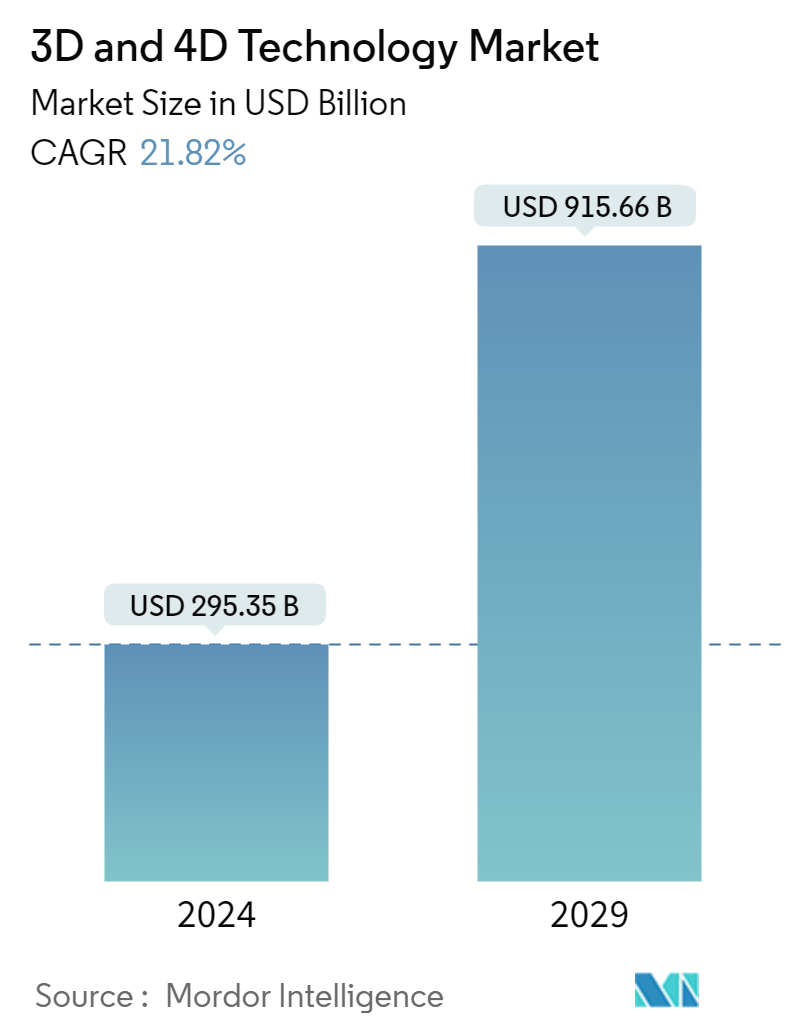
| Study Period | 2019 - 2029 |
| Market Size (2024) | USD 295.35 Billion |
| Market Size (2029) | USD 915.66 Billion |
| CAGR (2024 - 2029) | 21.82 % |
| Fastest Growing Market | Asia Pacific |
| Largest Market | North America |
Major Players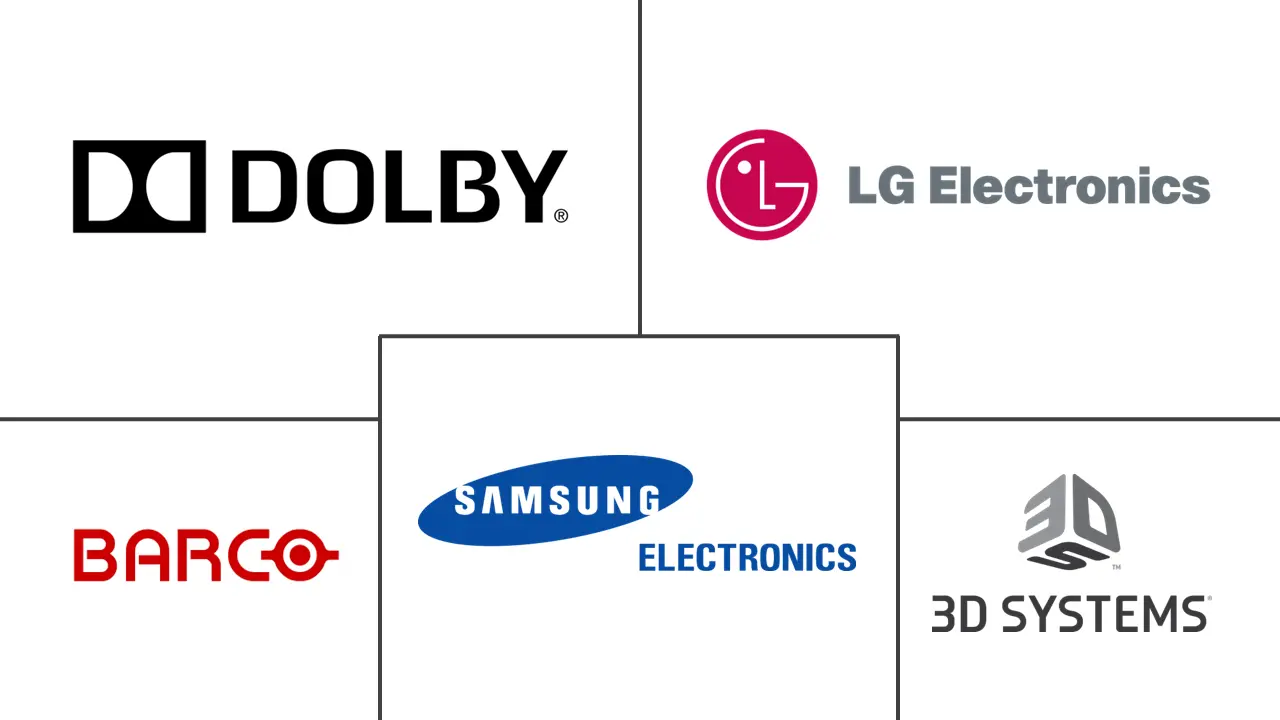
*Disclaimer: Major Players sorted in no particular order |
Need a report that reflects how COVID-19 has impacted this market and its growth?
3D & 4D Technology Market Analysis
The 3D & 4D Technology Market size is estimated at USD 295.35 billion in 2024, and is expected to reach USD 915.66 billion by 2029, growing at a CAGR of 21.82% during the forecast period (2024-2029).
3D and 4D technology are swiftly gaining popularity in various industries like healthcare, entertainment, education, manufacturing, automotive, and others due to their advanced visual effects, animations, and graphics capabilities. The 3D and 4D technologies provide a comprehensive platform for hand-drawn animation and physical impact. As a result of their superior technology, the adoption of 3D and 4D technologies has accelerated, which is likely to propel the market's growth.
- The increasing demand for 3D sensors in consumer electronics and the growing adoption of 3D sensors in the automotive industry is anticipated to drive the market's growth during the forecast period. The home gaming industry offered one of the first practical applications of 3D sensing for consumers, with time of flight (ToF) sensors capturing the movements and gestures of players to create a new interactive gaming experience.
- However, the arrival of 3D sensing is most noticeable in today’s smartphone technology. User-facing 3D scanning enhances security through facial recognition while world-facing 3D sensing creates new opportunities for high-performance depth-sensing photography and augmented reality. As the demand for 3D camera technology grows, illumination sources, LAS filters, and engineered diffuser production volumes are expected to soar.
- Further, biometric scanning and other 3D sensing applications are redefining the world of consumer electronics. Tablets and laptops are expanding on mobile devices' AR/VR, motion sensing, and security innovations. For instance, the gesture recognition capabilities of Microsoft Kinect that revolutionized the home gaming industry expanded to multi-player 3D position sensing, facial expression detection, and touchless heart rate monitoring.
- Face recognition functions have been added to 3D sensing applications, enhancing the security of laptop computers and mobile devices while boosting digital photo quality and resolution. Further, biometric scanning and other 3D sensing applications are redefining the world of consumer electronics. Tablets and laptops are expanding on mobile devices' AR/VR, motion sensing, and security innovations. For instance, the gesture recognition capabilities of Microsoft Kinect that transformed the home gaming industry expanded to multi-player 3D position sensing, facial expression detection, and touchless heart rate monitoring.
- Manufacturing with mixed materials or technological products (such as circuit boards) is still in production. 3D printed products are made of layers, which are not as strong as parts produced by conventional techniques, such as injection molding. Manufacturers currently need more in the size of products they can make with 3D printing. The technology’s ability to revolutionize mass-production manufacturing is still a long way off. Even today, 3D printers are still largely used for making one-off prototypes or small-scale print runs. Hence, the cost, availability, and material issues associated with 3D printing technologies hinder the market's growth.
- However, implementing 3D and 4D technologies can involve significant upfront costs, including hardware, software, content creation, and training. This cost barrier could limit adoption, especially for smaller businesses or industries with tighter budgets.
3D & 4D Technology Market Trends
Increasing Applications of 3D Printing Across Various End-user Industries
- 3D printers are used in numerous industries, including education, aerospace, healthcare, and non-custom prototyping. Further, 3D printing technology can also be employed to develop new manufacturing processes. The market is anticipated to benefit from innovative 3D and 4D-made shoes. The 4D cushioning in shoes is a contemporary creation for professional athletes and ordinary exercise consumers.
- Further, the potential of metal-based 3D printing would allow for the creation of rare, discontinued replacement parts in numerous applications. Repair shops can handle a variety of clientele, and online retailers can print unique parts, providing more products through a just-in-time inventory approach.
- The automobile industry is rapidly using 3D printing to prototype new car models. It is also used to produce spare and replacement parts in aerospace-related sectors. Further, healthcare has a wide variety of 3D printing applications ranging from molds in dentistry to prosthetics and 3D printed models for complex surgeries. It is promising to prevent card-present fraud in point-of-sale systems and ATMs. For instance, banks are now using 3D printing to design and produce ATM components that contain credit card skimming.
- For instance, Anycubic, a 3D printer manufacturer, recently announced its Anycubic Kobra series and Anycubic Photon M3 series of 3D printers, featuring advanced Anycubic LeviQ auto bed leveling technology and Anycubic LighTurbo matrix light source that provides a radically improved user-friendly experience and enhanced print details. The Kobra Max 3D printer features a build volume of 17.7 x 15.7 x 15.7. / 45 x 40 x 40 cm (HWD), which enables large-scale objects to be printed easily.
- Also, the United States-based 3D printer manufacturer 3D Systems recently entered a partnership with artificial intelligence (AI) medical firm Enhatch to design and deliver patient-specific medical devices more efficiently. The companies will combine their respective expertise and technologies to create an optimized, automated, and scalable workflow for fabricating medical devices through the partnership.
- According to Spiceworks, in North American and European organizations, IT automation technology emerged as the top trend, with 45% of respondents already utilizing it and 28% planning adoption within 2 years. Following closely, 5G technology stood as the second most favored, with 42% currently using it and 25% eyeing adoption within the next 2 years.
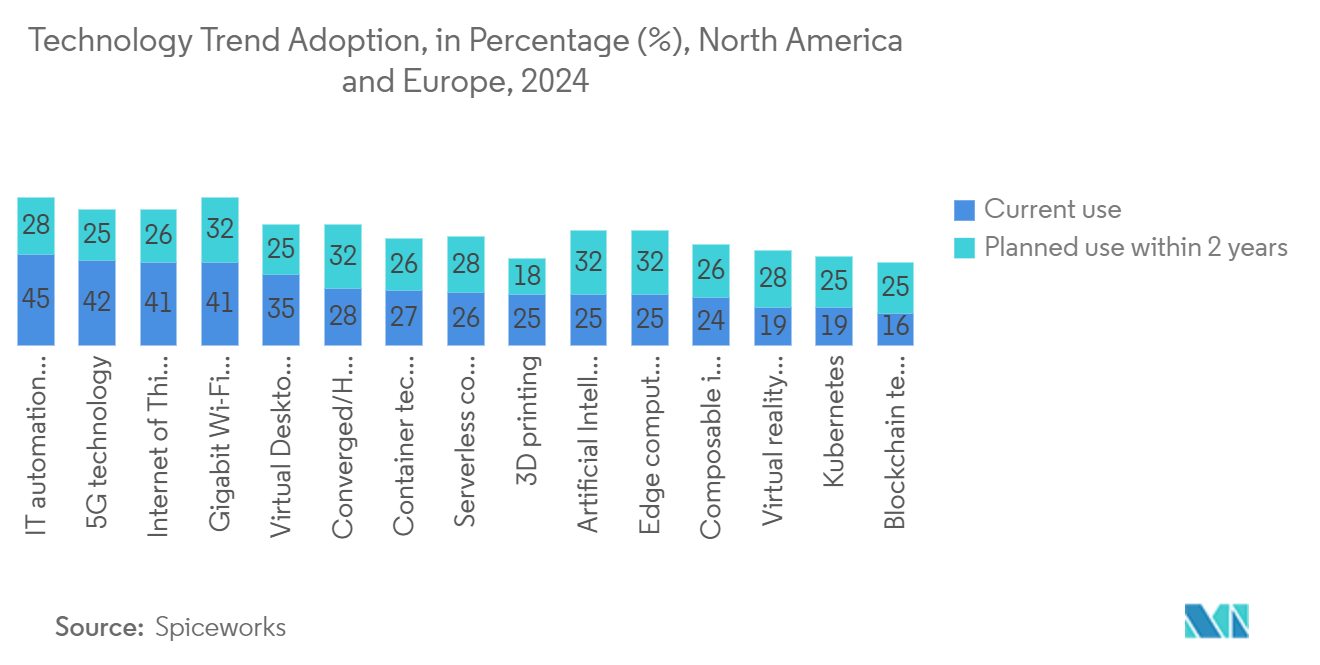
North America is Expected to be a Significant Market Share Holding Region
- The United States is one of the pioneers in adopting 3D and 4D technology and is expected to hold a prominent share in the 3D technology market. Furthermore, Growing incidences of chronic illnesses leading to organ and tissue transplants and a limited number of organ donors are among the primary factors driving the market growth.
- According to the Organ Procurement and Transplantation Network (OPTN), about 7500 people die while waiting for an organ transplant. Further, over 107,501 people in the country were waiting for an organ transplant. This shortage could be reduced by using 3D bioprinting to counter the increasing need for transplants.
- Moreover, LeddarTech, a prominent player in Level 1-5 ADAS and AD sensing technology, announced the availability of Leddar PixSet, a sensor dataset for ADAS and autonomous driving research and development. The dataset includes full-waveform data from Leddar Pixell, a 3D solid-state flash LiDAR sensor. The datasets offered free of charge for academic and research purposes are expected to further the device development, thereby driving market growth.
- According to an update, Scientists from the University at Buffalo recently developed a rapid new 3D bioprinting method that could represent a significant step toward fully printed human organs. The researchers developed a vat-SLA-based approach to reduce the time to create cell-laden hydrogel structures from 6 hours to 19 minutes. The updated bio-fabrication method has enabled the production of embedded blood vessel networks, making it a significant step towards efficiently creating 3D-printed organs.
- Also, in August 2022, According to an MIT announcement from a research team, the "first digitally made plasma sensors" for orbiting spacecraft have been produced. The sensors, often referred to as retarding potential analyzers (RPAs), are utilized by satellites to ascertain the atmospheric composition's chemical makeup and ion energy distribution. Hardware that was 3D printed and made using lasers performed on par with modern semiconductor plasma sensors made in a cleanroom.
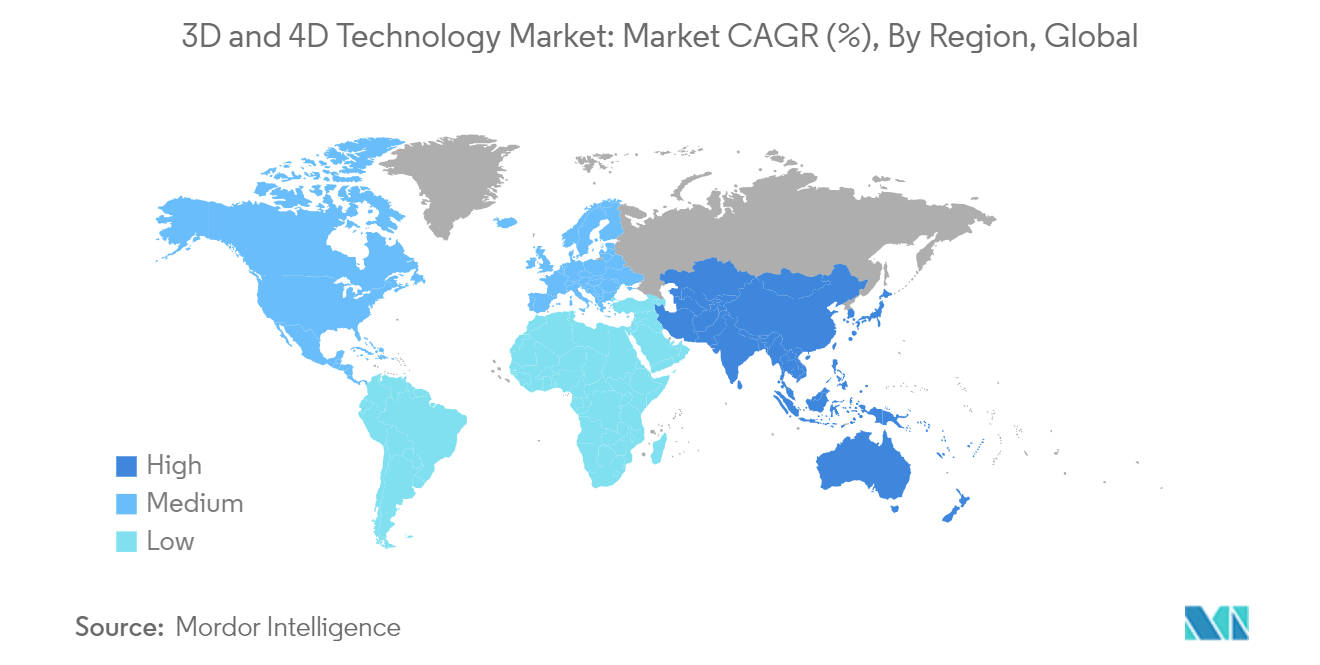
3D & 4D Technology Industry Overview
The global 3D 4D technology market is currently dominated by a few players in their respective industries with technological expertise. The global market is expected to be consolidated in nature, and the major players with a prominent share in the market are focusing on expanding their customer base across foreign countries by leveraging strategic mergers and collaborative initiatives to increase their market share and profitability. 3D Systems Corporation, Dolby Laboratories, Inc., LG Electronics Inc., Barco N.V., Samsung Electronics Co., Ltd., Autodesk, Inc., Stratus's, Inc., Panasonic Corporation, and Sony Corporation are some of the prominent players present in the current market.
In August 2023, Dimenco, a Netherlands-based player in display technology, was acquired by Leia Inc., a prominent 3D display hardware and content services supplier. This strategic decision combines the strengths of two 3D industry players and is expected to accelerate the widespread adoption of immersive 3D experiences across platforms and devices. This merger might benefit customers looking for a single, cross-platform solution built on a common industry standard.
In July 2023, 3D Systems Corporation stated that the business anticipates an immediate termination of the merger agreement with Desktop Metal, Inc. following Stratasys Ltd.'s decision to consider 3D Systems' merger proposal superior. According to 3D Systems, the decision was made after Stratasys shareholders expressed their opposition to the Desktop Metal merger. A merger agreement between 3D Systems and Stratasys has already been completed; it is now in escrow. 3D Systems anticipates Stratasys to countersign it soon.
3D & 4D Technology Market Leaders
-
3D Systems Corporation
-
Dolby Laboratories, Inc.
-
LG Electronics Inc.
-
Barco N.V.
-
Samsung Electronics Co., Ltd.
*Disclaimer: Major Players sorted in no particular order
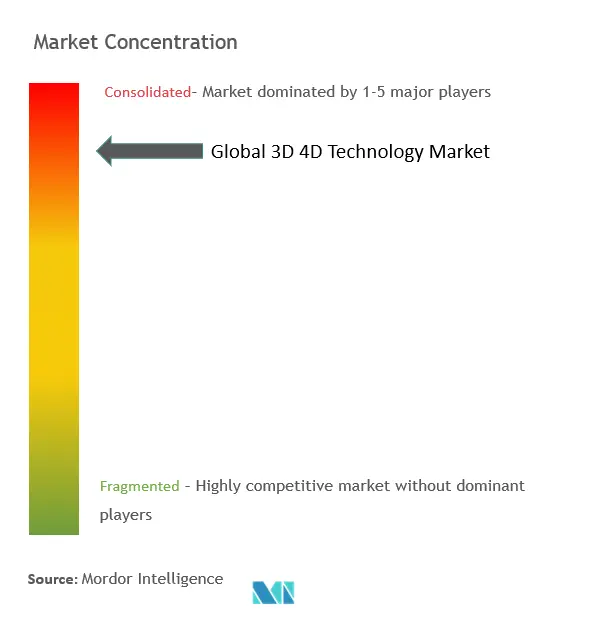
3D & 4D Technology Market News
- June 2023: Epic Games, the creators of Fortnite and Unreal Engine, and LVMH, a France-based luxury goods conglomerate, partnered to modernize the Group's creative process and offer clients new immersive product discovery experiences. Due to this strategic partnership with Epic, LVMH and its brands will be able to provide experiences like virtual fitting rooms and fashion shows, 360-degree product carousels, augmented reality, the development of digital twins, and more.
- May 2023: A strategic partnership between Formlabs and Hawk Ridge Systems has been announced to increase North American access to digital manufacturing technologies. Customers of Hawk Ridge Systems now have access to the entire Formlabs ecosystem of 3D printers, materials, and solutions. According to the companies, the partnership will combine 40 years of experience in additive manufacturing, allowing more manufacturers and users in various industries to access in-house 3D printing technology with quicker product development cycles, more design flexibility, and reduced reliance on outside manufacturers.
3D & 4D Technology Market Report - Table of Contents
1. INTRODUCTION
- 1.1 Study Deliverables
- 1.2 Study Assumptions
- 1.3 Scope of the Study
2. RESEARCH METHODOLOGY
3. EXECUTIVE SUMMARY
4. MARKET DYNAMICS
- 4.1 Market Overview
- 4.2 Introduction to Market Drivers and Restraints
-
4.3 Market Drivers
- 4.3.1 Increasing Applications of 3D Technology Across Various End-User Industries
- 4.3.2 Increasing Demand for 3D Technology in the Entertainment Industry
- 4.3.3 Increased Investment in R&D to Drive Development of Cost-Effective 3D Technology
-
4.4 Market Restraints
- 4.4.1 High Product Associated Costs and Availability of 3D Printing Materials
- 4.5 Industry Value Chain Analysis
-
4.6 Industry Attractiveness - Porter's Five Forces Analysis
- 4.6.1 Threat of New Entrants
- 4.6.2 Bargaining Power of Buyers/Consumers
- 4.6.3 Bargaining Power of Suppliers
- 4.6.4 Threat of Substitute Products
- 4.6.5 Intensity of Competitive Rivalry
- 4.7 Assessment of the impact of COVID-19 on the Market
5. MARKET SEGMENTATION
-
5.1 By Products
- 5.1.1 3D Sensors
- 5.1.2 3D Integrated Circuits
- 5.1.3 3D Transistors
- 5.1.4 3D Printer
- 5.1.5 3D Gaming
- 5.1.6 Other Products
-
5.2 By End-User Industry
- 5.2.1 Healthcare
- 5.2.2 Entertainment & Media
- 5.2.3 Education
- 5.2.4 Other End-user Industries
-
5.3 By Geography***
- 5.3.1 North America
- 5.3.2 Europe
- 5.3.3 Asia
- 5.3.4 Australia and New Zealand
- 5.3.5 Latin America
- 5.3.6 Middle East and Africa
6. COMPETITIVE LANDSCAPE
-
6.1 Company Profiles*
- 6.1.1 3D Systems Corporation
- 6.1.2 Dolby Laboratories, Inc.
- 6.1.3 LG Electronics Inc.
- 6.1.4 Barco N.V.
- 6.1.5 Samsung Electronics Co., Ltd.
- 6.1.6 Autodesk, Inc.
- 6.1.7 Stratus's, Inc.
- 6.1.8 Panasonic Corporation
- 6.1.9 Sony Corporation
- 6.1.10 Intel Corporation
7. INVESTMENT ANALYSIS
8. MARKET OPPORTUNITIES AND FUTURE TRENDS
** Subject To Availablity3D & 4D Technology Industry Segmentation
Technologies that use 3D visual representations to produce real-life or different virtual experiences. Such experiences range from technological overlap to fully immersive reality gadgets.
4D technology operates in all four conventional dimensions. It is a key notion in physics that, although referring to three-dimensional space (3D), also includes the dimension of time in addition to the other three dimensions (which are length, width, and depth).
The 3D 4D technology market is segmented by type (3D sensors, 3D integrated circuits, 3D transistors, 3D printers, 3D gaming, and other products), end-user industry (healthcare, entertainment & media, education, and other end-user industries), and geography (North America, Europe, Asia-Pacific, Latin America, and Middle East and Africa). The market sizes and forecasts are provided in terms of value in USD for all the above segments.
| By Products | 3D Sensors |
| 3D Integrated Circuits | |
| 3D Transistors | |
| 3D Printer | |
| 3D Gaming | |
| Other Products | |
| By End-User Industry | Healthcare |
| Entertainment & Media | |
| Education | |
| Other End-user Industries | |
| By Geography*** | North America |
| Europe | |
| Asia | |
| Australia and New Zealand | |
| Latin America | |
| Middle East and Africa |
3D & 4D Technology Market Research FAQs
How big is the 3D & 4D Technology Market?
The 3D & 4D Technology Market size is expected to reach USD 295.35 billion in 2024 and grow at a CAGR of 21.82% to reach USD 915.66 billion by 2029.
What is the current 3D & 4D Technology Market size?
In 2024, the 3D & 4D Technology Market size is expected to reach USD 295.35 billion.
Who are the key players in 3D & 4D Technology Market?
3D Systems Corporation, Dolby Laboratories, Inc., LG Electronics Inc., Barco N.V. and Samsung Electronics Co., Ltd. are the major companies operating in the 3D & 4D Technology Market.
Which is the fastest growing region in 3D & 4D Technology Market?
Asia Pacific is estimated to grow at the highest CAGR over the forecast period (2024-2029).
Which region has the biggest share in 3D & 4D Technology Market?
In 2024, the North America accounts for the largest market share in 3D & 4D Technology Market.
What years does this 3D & 4D Technology Market cover, and what was the market size in 2023?
In 2023, the 3D & 4D Technology Market size was estimated at USD 230.90 billion. The report covers the 3D & 4D Technology Market historical market size for years: 2019, 2020, 2021, 2022 and 2023. The report also forecasts the 3D & 4D Technology Market size for years: 2024, 2025, 2026, 2027, 2028 and 2029.
3D & 4D Technology Industry Report
Statistics for the 2024 3D & 4D Technology market share, size and revenue growth rate, created by Mordor Intelligence™ Industry Reports. 3D & 4D Technology analysis includes a market forecast outlook to 2029 and historical overview. Get a sample of this industry analysis as a free report PDF download.

